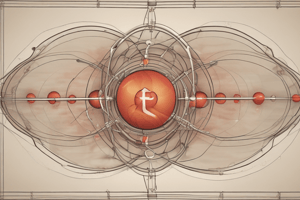Podcast
Questions and Answers
What is an isotope of an element?
What is an isotope of an element?
- A version of an element with a different number of orbitals
- A version of an element with a different number of neutrons (correct)
- A version of an element with a different number of protons
- A version of an element with a different number of electrons
What is the electron configuration of an atom?
What is the electron configuration of an atom?
- The distribution of protons in an atom
- The distribution of atoms in an atom
- The distribution of electrons in an atom (correct)
- The distribution of neutrons in an atom
What is the maximum number of electrons that an 'f' orbital can hold?
What is the maximum number of electrons that an 'f' orbital can hold?
- 10 electrons
- 2 electrons
- 14 electrons (correct)
- 6 electrons
What are valence electrons?
What are valence electrons?
What is the Pauli Exclusion Principle?
What is the Pauli Exclusion Principle?
What type of wave is used for thermal imaging and remote controls?
What type of wave is used for thermal imaging and remote controls?
What is an emission spectrum?
What is an emission spectrum?
What is the purpose of X-rays?
What is the purpose of X-rays?
What determines how atoms interact with each other?
What determines how atoms interact with each other?
What do all the orbitals in the same sublevel have in common?
What do all the orbitals in the same sublevel have in common?
What is the principal quantum number (N) in electron configuration?
What is the principal quantum number (N) in electron configuration?
What happens to the energy and distance from the nucleus as the principal quantum number (N) increases?
What happens to the energy and distance from the nucleus as the principal quantum number (N) increases?
What is the relationship between the row of the periodic table and the coefficient in electron configuration?
What is the relationship between the row of the periodic table and the coefficient in electron configuration?
What determines an atom's reactivity with other elements?
What determines an atom's reactivity with other elements?
What can students do with the knowledge of electron configuration and orbital diagrams?
What can students do with the knowledge of electron configuration and orbital diagrams?
What can students identify on the periodic table?
What can students identify on the periodic table?
Flashcards are hidden until you start studying
Study Notes
Basics of Atomic Structure
- The higher the coefficient or shell, the higher the energy of an atom.
- The arrangement of electrons in an atom determines how it interacts with other atoms.
- The arrangement of electrons in each atom determines its physical properties.
- All orbitals in the same sublevel (e.g. 2s, 1s, 3p) have the same amount of energy.
- Mass Number = Protons + Neutrons, not shown on the periodic table.
- Atomic Number = Protons, shown as the large number on the periodic table.
- Average Atomic Mass = average mass of all isotopes of an element.
Principal Quantum Number
- Principal Quantum Number (N) describes the energy level and size of an orbital.
- As N increases, the energy and distance from the nucleus also increase.
- N can be any positive integer (1, 2, 3, 4, ...).
- Orbitals do not exist unless an electron is occupying it.
- Orbitals are the last shell level.
Periodic Table
- The periodic table is split into blocks, with rows corresponding to the coefficient in electron configuration.
- For the d block, the coefficient is one less than the row it is in.
- The exponent is the number of columns from the left of the start of the specific letter block.
- Students can explain the reasoning behind the organization of the periodic table.
Electron Configuration and Orbitals
- Students can construct the appropriate electron configuration and orbital diagram for a given element.
- Students can identify the alkali metals, alkaline earth metals, transitional metals, halogens, noble gases, metals, non-metals, and metalloids on the periodic table.
Vocabulary
- Isotope: a different version of an element with a different number of neutrons.
- Ground State: the lowest energy state of an atom or other particle.
- Electron Configuration: the distribution of electrons in an atom.
- Orbital: a region around the nucleus that can hold a specific number of electrons (s: 2, p: 6, d: 10, f: 14).
- Valence Electrons: electrons that are furthest from the nucleus and have the most energy.
- Protons: positively charged particles found in the nucleus.
- Neutrons: neutrally charged particles found in the nucleus.
- Electrons: negatively charged particles found around the nucleus.
- Nucleus: the center of the atom, positively charged, containing protons and neutrons.
- Electron Cloud: the area around the nucleus where there is a negative charge.
Principles/Laws
- Pauli Exclusion Principle: electrons in the same orbital must have a different spin.
- Hund's Rule: in a sublevel, all orbitals get one electron before pairing up.
- Aufbau Principle: fill orbitals from low energy to high energy (s → p).
Unit 7: Wave Types
- Radio Waves: much longer wavelength than visible light, used for communication.
- Microwave: used for cooking, heat application, and communication, similar to radio waves.
- Infrared: used for thermal imaging and remote controls.
- Ultraviolet: used for killing bacteria and creating fluorescent effects, but can damage cells.
- X-Ray: used for imaging, but can damage molecular structure and cause harm.
- Gamma Rays: used to treat cancer, but can damage the entire body.
Emissions Spectra
- Each element has a unique emission spectra.
- Emission spectra shows the colors of light emitted when an element is hit with the right wavelength needed to make a jump to a higher energy level.
Studying That Suits You
Use AI to generate personalized quizzes and flashcards to suit your learning preferences.




